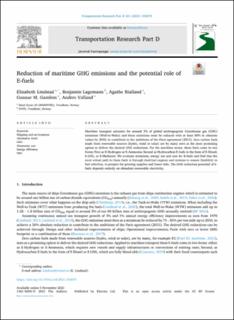| dc.contributor.author | Lindstad, Elizabeth | |
| dc.contributor.author | Lagemann, Benjamin | |
| dc.contributor.author | Rialland, Agathe Isabelle | |
| dc.contributor.author | Gamlem, Gunnar Malm | |
| dc.contributor.author | Valland, Anders | |
| dc.date.accessioned | 2022-06-22T06:37:41Z | |
| dc.date.available | 2022-06-22T06:37:41Z | |
| dc.date.created | 2021-11-22T13:17:11Z | |
| dc.date.issued | 2021 | |
| dc.identifier.citation | Transportation Research Part D: Transport and Environment. 2021, 101, 1-15. | en_US |
| dc.identifier.issn | 1361-9209 | |
| dc.identifier.uri | https://hdl.handle.net/11250/2999928 | |
| dc.description.abstract | Maritime transport accounts for around 3% of global anthropogenic Greenhouse gas (GHG) emissions (Well-to-Wake) and these emissions must be reduced with at least 50% in absolute values by 2050, to contribute to the ambitions of the Paris agreement (2015). Zero carbon fuels made from renewable sources (hydro, wind or solar) are by many seen as the most promising option to deliver the desired GHG reductions. For the maritime sector, these fuels come in two forms: First as E-Hydrogen or E-Ammonia; Second as Hydrocarbon E-fuels in the form of E-Diesel, E-LNG, or E-Methanol. We evaluate emissions, energy use and cost for E-fuels and find that the most robust path to these fuels is through dual-fuel engines and systems to ensure flexibility in fuel selection, to prepare for growing supplies and lower risks. The GHG reduction potential of E-fuels depends entirely on abundant renewable electricity. | en_US |
| dc.language.iso | eng | en_US |
| dc.publisher | Elsevier | en_US |
| dc.rights | Navngivelse 4.0 Internasjonal | * |
| dc.rights.uri | http://creativecommons.org/licenses/by/4.0/deed.no | * |
| dc.subject | IMO | en_US |
| dc.subject | Energy efficiency | en_US |
| dc.subject | Abatement cost | en_US |
| dc.subject | GHG | en_US |
| dc.subject | Alternative Fuels | en_US |
| dc.subject | Shipping and environment | en_US |
| dc.title | Reduction of maritime GHG emissions and the potential role of E-fuels | en_US |
| dc.type | Peer reviewed | en_US |
| dc.type | Journal article | en_US |
| dc.description.version | publishedVersion | en_US |
| dc.rights.holder | © 2021 The Authors. Published by Elsevier Ltd. | en_US |
| dc.source.pagenumber | 15 | en_US |
| dc.source.volume | 101 | en_US |
| dc.source.journal | Transportation Research Part D: Transport and Environment | en_US |
| dc.identifier.doi | 10.1016/j.trd.2021.103075 | |
| dc.identifier.cristin | 1957305 | |
| dc.relation.project | Norges forskningsråd: 237917 | en_US |
| dc.source.articlenumber | 103075 | en_US |
| cristin.ispublished | true | |
| cristin.fulltext | original | |
| cristin.qualitycode | 2 | |

